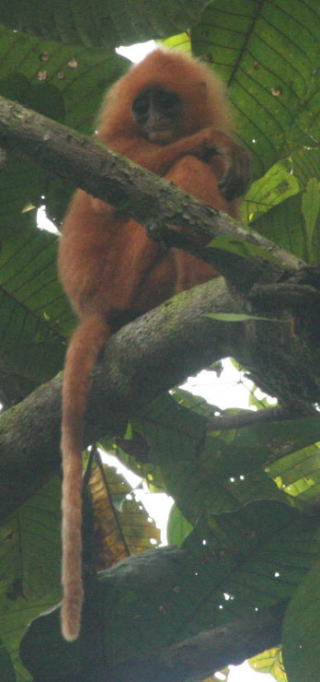Community ecology of primates in Southeast Asian tropics: effect of mast fruiting
General flowering and proceeding mast fruiting is unique to Southeast Asian tropics, such as Borneo, Sumatra and Malay Peninsula. With an unpredictable periodicity of 1-5 years, various species of trees set flower and then bear fruits. However, fruit production out of mast fruiting is very low compared to African or American tropics.
How frugivorous animals respond to this extremely high seasonality? Primates are the groups whose biomass is one of the largest among the tropical fauna, and they can utilize diverse array of resources, including fruits, seeds, leaves, invertebrates, and fungi. They live in an arboreal space, where most other large mammals cannot use but plants produce most of the primary production. In Bornean and Sumatran forests, great apes (orangutans), lesser apes (gibbons), macaques and leaf monkeys live sympatrically, so it is very interesting to reveal the mechanism that these primates coexist and partition the resources in these highly seasonal environments.
In order to reveal the coexistence mechanism of these diurnal primates, I conducted fieldwork in Danum Valley Conservation Area in Sabah, a Malaysian state in Borneo. In this forest, five diurnal primates, including orangutans (Pongo pygmaeus), Bornean (or Muller's) gibbons (Hylobates muelleri), red leaf monkeys (Presbytis rubicunda), long-tailed macaques (Macaca fascicularis), and pig-tailed macaques (Macaca nemestrina) are distributed.
1. Land use by five species of primates and its seasonal changes
I set census trails of 10 km in length in total. I conducted census for ca 7 times in a month and recorded the primates detected along the census trails. There was no horizontal habitat segregation, but the forest strata use differed among the five species. Only orangutans increased their number in response to a fruiting peak simultaneously in the two study sites which were 10 km apart from each other.
See the abstract
2. Inter-species encounter
I examined the frequency and duration of inter-species encounter among the diurnal primates in Danum Valley and compared them with the expected values calculated from density and travel speed of these specie. The frequency that multiple species were detected during route census was as low as the chance level. The frequency of encounter while tracking a group of red leaf monkeys was lower than expected values with gibbons and long-tailed macaques, but higher with orangutans in non-fruiting months. This tendency disappeared in fruiting months, so the association of orangutans and red leaf monkeys was regarded as an independent aggregation to food patches. This is the second study among primate communities in Asia which quantitatively shows the absence of active and consistent formation of polyspecific associations.
See the abstract
3. Response to mast fruiting: red leaf monkeys
Intensive observational study was conducted for red leaf monkeys from December 2006 to December 2008. One mast fruiting event occurred during the two year study period.
They changed their main food from seeds to young leaf of Spatholobus macropterus, a liana of Leguminasae, when the fruit availability decreased. Consumed young leaves contained more crude protein than young leaves of non-consumed species, and among the consumed species, red leaf monkeys consumed species which was abundant in their habitat. In the lowland dipterocarp forest where fruit scarcity lasts for a prolonged and unpredictable period, both quality and abundance are important in selecting fallback foods.
See the abstract
Red leaf monkeys extended their time spent feeding on seeds as much as 18 fold. In response to increased fruiting seasonality, the monkeys increased the number of species and plant individuals upon whose seeds they depredated. However, time spent feeding on seeds per species or individual, or for the most frequently eaten species or individual, was not affected by fruit availability. The existence of an abundant alternative resource (young leaves) is one of several likely reasons for the weak persistence toward seeds shown by red leaf monkeys, which is contradictory to the assumption of the predator satiation hypothesis.
See the abstract
Young leaves and seeds are the two important foods for red leaf monkeys. I compare their roles in the diet of this species. The availability was larger for young leaves, but there was no nutrtional advantage for young leaves when both food and non-food species were analyzed. Seeds were rich with lipid, so good for energy source. However, as monkeys were more selective when eating young leaves than eating seeds, when only food species were analyzed, young leaves were rich with mineral (crude ash) and digestible protein, indicating young leaves and seeds play different, complementary roles in the diet.
See the abstract
Home range of the study group of red leaf monkeys was small (21.4 ha), but the daily path length was relatively long (1160 m), and the ranging pattern was not affected by the seasonal variations in the diet, even thoug they experience mast fruiting. The group’s ranging patterns may be related to the unusual fallback strategy of this population, which depends on the young leaves of an abundant liana (Spatholobus macropterus), which are available in small patches.
See the abstract
The reason I chose red leaf monkeys among the five species is only because it was the easiest one. Their home range is only 20 ha, and was very flat, which is very different from the mountainous Yakushima. When I observed red leaf monkeys, I often thought I cannot be back to Yakushima when I get accustomed to this situation.
